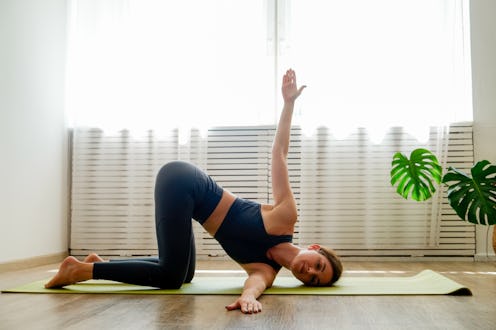Fitness
The "Thread The Needle" Pose Is Your Hero For Hunched Shoulders
You'll want to try it ASAP.

If your life revolves around sitting at a desk with rounded shoulders as you type or look down at your phone, then you need to stop everything, unfurl a yoga mat, and try the “thread the needle” pose. Like, right now.
The thread the needle pose is the ideal stretch for undoing all the side effects of poor posture. Not only does it open up tight shoulders, but it also stretches your back and facilitates a gentle spinal rotation, says Joy Puleo, MA, PMA-CPT, PT, ACSM, a certified Pilates instructor and director of education at Balanced Body. This move also helps improve rounded shoulders by gradually realigning your spine, adds Denise Prichard, an RYT-200 hour certified yoga instructor and wellness council member for Mindbody and ClassPass. All things that’ll feel so, so good after sitting at a computer for hours on end.
The stretch can relieve aches and pains the moment you do it — Puleo says it’ll make your shoulders feel “light and free” pretty much instantly — but finding ways to counteract rounded shoulders on a regular basis will also save you from experiencing posture-related health issues down the road, like chronic neck pain, headaches, lower back strain, and even poor circulation, Prichard adds.
To truly correct your hunched shoulder situation, Prichard recommends incorporating this move into your wellness routine on a daily basis. Read on below to learn more about “thread the needle” and how to do it correctly.
Why It Works
Hunching over a computer or constantly looking down at your phone can really do a number on the muscles and connective tissues in your upper back, shoulders, neck, and even your lower back, Puleo says. “Any static posture, any holding and fixing in place over time, will lead to a remolding of the soft tissue or connective tissue,” she explains.
This is especially true when it comes to hunched shoulders, because the human head is just so darn heavy. Every time it hangs forward, your muscles have to work overtime to support its weight, which is about 10 to 15 pounds. And eventually, these muscles become rigid and less fluid, Puleo says.
Basically, the more you slouch, the more your body gets used to slouching, and it becomes even more difficult to push your shoulders back and maintain good posture. But that’s where “thread the needle” comes in to save the day.
This pose rotates your spine, stretches the muscles of the upper back, and rotates the overhead shoulder to stretch the posterior shoulder of the arm that threads under the body, Puleo says. “It is a dynamic stretch, which encourages blood flow and circulation to all of these areas and helps to mobilize the connective tissue, as well as stretch structures that are held in the ‘hunched’ posture.”
How To Do The “Thread The Needle” Yoga Pose
Here, Prichard explains how to thread the needle with good form.
- Start in a tabletop position on all fours.
- Make sure that your shoulders are directly over your wrists and your hips are directly over your knees.
- Open your chest by reaching your right arm up to the ceiling.
- Look up at the ceiling to stretch, then carefully sweep your right arm back down and “thread” it underneath your armpit.
- Walk the fingertips on your left hand forward for support as you let the right side of your head rest on the mat.
- Continue to reach your right fingertips to the left until you feel a stretch in your shoulders and back.
- Keep both knees and your left arm grounded for support.
- Hold this pose for five breaths, then repeat on the other side.
How To Modify “Thread The Needle”
There are a couple of ways to modify this pose. If it hurts to kneel on your knees, you can sit in a chair and put your hands on a table in front of you to thread the needle there. Follow the same movements as above while seated. “In this case, the right arm reaches up toward the ceiling, the spine rotates as the chest opens, then you thread the arm under the body,” Puleo says.
Another way to ease up is by leaning back on a bolster or towel that’s placed across your lower legs. “This will allow the lower back to stretch while also relieving direct pressure on the knees,” Puleo says.
To make the stretch even deeper, you can sit back into child’s pose, which Puleo says will provide a bigger stretch in the lower back. “Another lovely way to accentuate the stretch is to find ‘opposition’ in all the movement,” she adds. You can do this by reaching further away with both hands. “Always thinking of lengthening the spine will enhance spinal mobility.” And it’ll feel so good.
Studies referenced:
Barassi, G. (2021). Posture and Health: Are the Biomechanical Postural Evaluation and the Postural Evaluation Questionnaire Comparable to and Predictive of the Digitized Biometrics Examination? Int J Environ Res Public Health. https://www.ncbi.nlm.nih.gov/pmc/articles/PMC8038060/
Ertekin, E. (2021.) Neck pain in rounded shoulder posture: Clinico-radiologic correlation by shear wave elastography. Int J Clin Pract. doi: 10.1111/ijcp.14240.
Hotta, K. (2018.) Daily muscle stretching enhances blood flow, endothelial function, capillarity, vascular volume and connectivity in aged skeletal muscle. J Physiol. doi: 10.1113/JP275459.
Kwon, J.W. (2015). Changes in upper-extremity muscle activities due to head position in subjects with a forward head posture and rounded shoulders. J Phys Ther Sci. https://www.ncbi.nlm.nih.gov/pmc/articles/PMC4499973/
Łastowiecka-Moras, E. (2017.) How posture influences venous blood flow in the lower limbs: results of a study using photoplethysmography. Int J Occup Saf Ergon. doi: 10.1080/10803548.2016.1256938.
Singla, D. (2017.) Association Between Forward Head, Rounded Shoulders, and Increased Thoracic Kyphosis: A Review of the Literature. J Chiropr Med. doi: 10.1016/j.jcm.2017.03.004.
Sources:
Joy Puleo, MA, PMA-CPT, PT, ACSM, certified Pilates instructor
Denise Prichard, RYT-200 hour certified yoga instructor
This article was originally published on